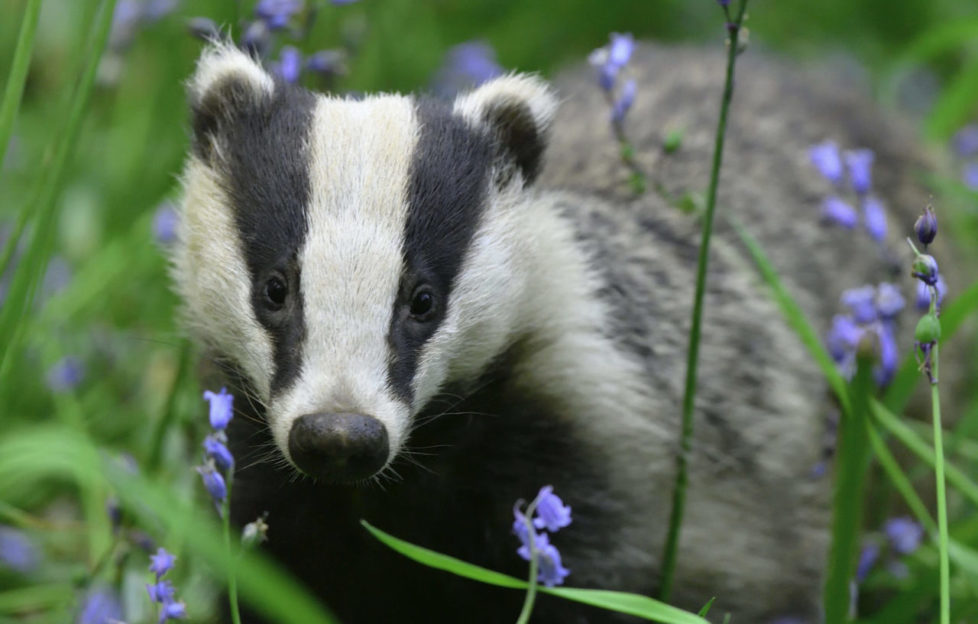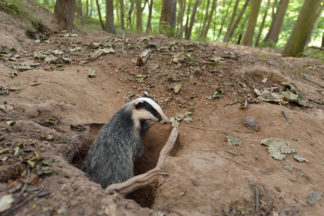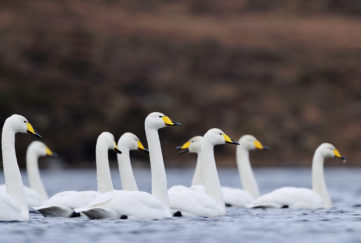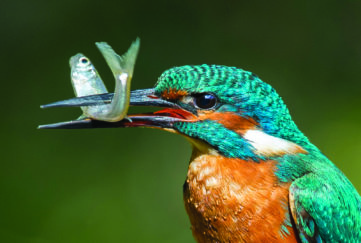Secret Lives Of Badgers – Jim Crumley

 Uncovering the habits of these elusive, nocturnal creatures takes a great deal of patience and intimacy with nature…
Uncovering the habits of these elusive, nocturnal creatures takes a great deal of patience and intimacy with nature…
There had been a badger survey. When it alighted on my neck of the woods it concluded that the badgers had gone. I was stopped one day by a casual acquaintance and told that the surveyor had been and did I know that there are no badgers left? This was bad news, but only if it were true.
There are two ways to respond to such news. You can trust the source and take it at face value, or you can distrust the source. The survey found nothing and concluded that there was nothing to be found. I find fault with that particular methodology.
Besides, I never cared much for wildlife surveys, for if it is a national survey like that one, what they produce is a snapshot of a moment in time in many different places.
I incline towards the opposite way of working. I produce many snapshots in one place over many years. I believe the results are more trustworthy, not least because if I discover that a well-established presence has suddenly become an absence, the first thing I do is cast around to see if it has simply moved to somewhere else in the neighbourhood.
I have chosen to work a territory for many years now, crossing and re-crossing the same landscape, compiling and constantly revising a mental map of what’s where and how it interacts with everything else. The resultant knowledge is a kind of intimacy. So the survey’s conclusion surprised me.
The sett is an old one and has been continuously occupied for more than 40 years to my certain knowledge, and quite possibly for several times longer than that, for such is often the pedigree of old and undisturbed setts. This one was both old and undisturbed, and it was well hidden. So unless the landowner had taken a sudden dislike to badgers, it was difficult to explain their absence. On the other hand, it does sometimes happen that a sett “goes cold”, but when it does, the explanation is usually obvious and man-made. So I went in search of an explanation.
The sett lies in a woodland clearing. The wood itself is a thing of beauty – oak and ash, beech and birch, sycamore and Scots pine, rowan and willow. As soon as you enter it you must climb a steep bank smothered at this time of year in wild hyacinths, also known to the botanically careless as bluebells.

Credit: Shutterstock
In Scotland the tradition was to call them the botanically correct wild hyacinth, and to use bluebell for that much more delicate and less fragrant flower that England calls the harebell.
The evening was late April, sunlit and blessed with a gentle easterly that suited my purpose.
Even before I was in the midst of the trees, even before I reached that mischievous little rowan that fankles progress on an awkward diagonal path where I choose to enter the wood, even before I had finished with the short stretch of narrow road between my parked car and my hidden way in… even before any of that I was drenched and dizzied by the hyacinth scent.
The whole bank, top to bottom and edge to edge and something between a quarter and a half a square mile, was floored with a magic carpet, a make-believe landscape of improbable blue. I half expected hobbits. The flowers were so densely packed that to take any one step was to flatten a dozen or more and release a new cloud of scent.
By an exquisite trick of the light, the carpet paled into the distance, and at the furthest reach of the wood the effect was of a lilac-shaded ground mist in which every tree appeared to wade and every fallen trunk and broken-off limb was embalmed.
I sought out the beginning of a path the width of one walking badger, which I know of old.
I evolved a theory as I walked. If the survey was correct in its conclusion, I guessed that the little path would have been consumed by the glacier of blue that had overwhelmed the bank and that it would be difficult to find. But if it was still clearly defined, that would mean that at the very least there were still enough badgers in the area to maintain one of their oldest routes.
Not all badgers from the same sett use all their paths all the time, and a sett like this one radiates paths to almost every compass point. Some badgers leave the sett by the same path every night. Even a single badgerless week at this time of year could be enough to diminish the path’s imprint, such was the fecund growth on the woodland floor.
I looked down the bank from the top and there was barely a hint of my uphill passage as the breeze drifted flowers across the faint line of my footsteps. Then a holly tree stood before me and I remembered the badger path veered away just beyond it. So I skirted the tree and there was the path. But its appearance was inconclusive.
The flowers had been parted, but there was not a scrap of bare earth, and what I remembered was a path of bare earth. The effect was of a ghost path, and somehow that notion enhanced the prospect of hobbits.
Perhaps there had been a hiatus, or perhaps now there were too few badgers to maintain a path so far from the sett, or perhaps they mostly avoided it when the flowers were in their prime because such a weight of hyacinth scent compromised their sense of smell, a crucial element of their way of life.
I descended the far side of the bank and closed in on the sett. Its clearing is gently domed and the heart of the sett was just below the crown of the dome where a single rowan tree provided a simple marker from a distance. I studied the clearing through binoculars. At that distance it did look as if it might have gone cold.
The entrance holes were hidden but if the sett was busy there would have been spoil heaps of freshly dug earth lolling down the slope and shaped like the panting tongues of big dogs. There were none.
An old wall and a line of beech trees defined the clearing at its nearest edge. I was 50 yards from the nearest beech, 150 from the solitary rowan in the clearing. I was intent on the rowan and its immediate surroundings when I felt an awareness, as tangible as an itch, one of the fruits of hundreds of badger-watching hours.

Credit: L.Campbell
It is among the most priceless of the tools of my trade, that nudge in the ribs, that impulse to stop what you are doing and change direction because something tells you you’re looking in the wrong place.
So I looked along the line of the wall, and there at the base of the third beech trunk was the head and chest and forepaws of a substantial boar badger, sitting upright and staring at me. In this kind of situation, my job becomes almost laughably easy, for it demands of me that I do nothing at all. Nothing other than keep still, watch and remember. The badger has the difficult job, which is to decide what to make of my shape’s intrusion into his landscape.
Perhaps he had just caught sight of me at that moment as he stepped beyond the beech tree. Or he may have been watching my arrival and subsequent stillness for some time. The wind would not help him for the moment, as it blew towards me, not him.
He looked relaxed. He sat back like a bear and scratched under his chin and in his chest fur. He stood and shook himself like a wet dog, then sat again. His eyes had never left me, but badger eyes only tell a badger so much. They are not the keenest of his senses.
He advanced a few paces out into the open. My guess about this gesture was that I should be left in no doubt about his size and his power, so that I should recognise his overlordship in this neck of the woods. He raised his muzzle and sniffed the air for some time, but if it told him anything other than “hyacinth” I would be very surprised. If my presence troubled him enough, he had a choice: go back underground or circle behind me for a clearer scent, but he would know too that every other scent in the woods was overpowered by the flowers.
So he did neither.
He appeared to dismiss my threat, turned on his own length and trudged away so that at once he was hidden behind the wall and the big trees. I waited to see if he would reappear, crossing the clearing but he did not.
So I followed a hunch. I crossed the slope above the wall with all the discretion I could muster until I could see the area where he had been. He was still there. He had only moved a few yards and he was still grooming.
More importantly, I could now see that he was sitting in the midst of a very well populated badger village. There were holes everywhere, heaps and heaps of fresh earth, many flattened by the hijinks of new cubs. The centre of activity was near him but there were three more entrances near me, each with its own doormat of excavated earth.
So the survey had got it wrong. The sett had not gone cold. It had just gone 100 yards uphill and was thriving. I watched for another hour. That boar badger eventually wandered off into the woods. My initial thought was that he could have been the first to emerge, for I had arrived there quite early. But after a badgerless hour, I concluded he had been the last to emerge from the sett.
But I didn’t care. I had found what I came for. It was enough to know that all was well and to know that in an east wind there was a fine seat on a fallen tree trunk where I could watch whenever I chose.
I still don’t know why they moved uphill. I do know now that they have beaten a new path between the two setts and that at least two of the old holes have been reopened. And I know why they didn’t move far, thanks to an old friend who explained why some setts appear to have gone cold and then suddenly revitalise. He simply said, “Once a badger sett, always a badger sett.”
You can read more of Jim Crumley’s Scottish wildlife columns online here, and each month in The Scots Magazine.
Subscribe to The Scots Magazine today for more from Jim Crumley >>





